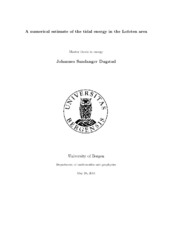| dc.contributor.author | Dugstad, Johannes Sandanger | eng |
| dc.date.accessioned | 2014-08-05T08:18:24Z | |
| dc.date.available | 2014-08-05T08:18:24Z | |
| dc.date.issued | 2014-05-28 | eng |
| dc.date.submitted | 2014-05-28 | eng |
| dc.identifier.uri | https://hdl.handle.net/1956/8238 | |
| dc.description.abstract | In the following study the energy potential associated with tidal energy will be investigated. A depth integrated model based on the Navier Stokes equations and the continuity equation will be applied to simulate the tides around the Lofoten area in the northern Norway. The model applies a 250 m grid resolution. The only tidal component taken into consideration is the \(M_2\)-component. In the study, computations of available potential and kinetic energy fluxes will be performed. It is computed a potential energy reservoir about 200 times larger than the kinetic energy for the Lofoten area. A substantial conversion of potential energy to kinetic energy occurs as the tide propagates from the deep ocean to the channels between the Lofoten islands. The Lofoten islands make a blocking effect which causes phase differences between the tide on the inside and the outside of the islands. The kinetic energy in the channels is estimated to \(2.45\) TWh. The potential energy in the channels is estimated to \(72.9\) TWh. | en_US |
| dc.format.extent | 2198730 bytes | eng |
| dc.format.mimetype | application/pdf | eng |
| dc.language.iso | eng | eng |
| dc.publisher | The University of Bergen | en_US |
| dc.title | A numerical estimate of the tidal energy in the Lofoten area | en_US |
| dc.type | Master thesis | |
| dc.rights.holder | Copyright the author. All rights reserved | en_US |
| dc.description.degree | Master i Energi | en_US |
| dc.description.localcode | MAMN-ENERG | |
| dc.description.localcode | ENERGI399 | |
| dc.subject.nus | 752903 | eng |
| fs.subjectcode | ENERGI399 | |
